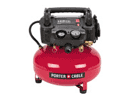How to Maintain an Air Compressor
 Having a good air compressor is a vital part of the woodworking and production industries. Accordingly, properly maintaining said air compressor is perhaps the most vital part of using and powering pneumatic equipment. Because your air compressor is the muscle behind your pneumatic tools, and behind your results as well, ensuring their performance from the ground up is just as important as your end results.
Having a good air compressor is a vital part of the woodworking and production industries. Accordingly, properly maintaining said air compressor is perhaps the most vital part of using and powering pneumatic equipment. Because your air compressor is the muscle behind your pneumatic tools, and behind your results as well, ensuring their performance from the ground up is just as important as your end results.
Read the Owner’s Manual –
The very first step to properly maintaining your air compressor (or any other piece of equipment for that matter) is becoming acquainted with the operating/owner’s manual. Although some crafters see their manuals as entirely inferior to their own massive knowledge, in reality, the manual contains a smorgasbord of truly valuable information that will help you ensure your compressor performs optimally for the longest possible amount of time. So, read and practice the guidelines in your operating manual, they will not lead you astray.
Storage –
Where you store your compressor is another important factor. Whether you use your compressor once per month or you use it everyday and store it only at night, you must store the thing in a cool, clean (dust-free) and dry environment. Where possible, you should also cover the machine ensuring it suffers from as few of the elements as possible.
Compressor Types –
Additionally, there are two main types of air compressor – those that require regular oiling (designed for the heaviest industrial applications) and those that are oil-less and therefore require no oiling (designed for lighter-duty applications). Oil-less compressors require less regular upkeep but also wear more quickly and consequently require replacement more often. On the other hand, compressors that require oiling, despite demanding a bit more attention from their operators, enjoy a rejuvenating oil-bath and the required regular maintenance that ensures healthy components and a longer life-span. Because you have already read your owner’s manual, you know which type of compressor you have.
Certain aspects of your compressor’s maintenance require a little more frequency that others. Some procedures need to be performed everyday or with every use, while others require attention only on a monthly or six-month basis. The following describes the best practices and time intervals for properly maintaining your air compressor.
Daily Maintenance –
On a daily basis or at least with every use, to prevent rust and water damage it is important to drain any moisture from the air compressor’s tanks. To do this you must first release the air pressure from the tanks, open the drain valves and allow all moisture to completely drain. If you work in a particularly dusty environment, it is also smart to blow or wipe any debris from the tool. This ensures your components remains clean and clear of clogging debris and perform optimally.
Weekly Maintenance –
Once per week, remove any debris or other such obstructions from the air intake vents. Wipe them down well ensuring they are clean as a whistle and, if you use a compressor with a filter, get that filter whistling clean as well (you’d be surprised how dirty these things can get) and replace it as needed. If you use your compressor extremely rarely, is is probably not necessary to do this each week, but do do it after (about) every five uses.
Monthly Maintenance –
Take a moment each month to give your compressor a good-old-fashioned check-up. Inspect its nooks and crannies paying special attention to moving parts, hoses and cords. Ensure the safety release valve opens properly, releases air pressure properly and closes properly without any air leakage. Similarly, ensure your hoses are leak free and in otherwise good condition, and that your cord doesn’t have any breaks, kinks, scrapes or cuts. Because the electrical hazard of using a damaged cord is so great, do not use your air compressor (or any other machine or appliance) with a damaged cord.
Bi-Yearly Maintenance –
Take a little bit more time about twice each year (every six-months) to ensure your most critical working parts are working correctly. Check each of the compressor’s fittings for air-tightness ensuring there are no leaks and test that your gauges are displaying the correct readings. Replace parts and filers where necessary, and, should you run into more serious issues, quickly take your air compressor to an authorized service center for professional inspection.
And that’s just about the size of it. Remember to give a little time back to your air compressor and it will continue powering your tools and projects for years to come.













